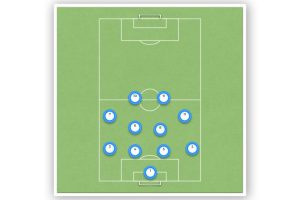Low Block Soccer Tactics: How to Defend Deep and Frustrate Opponents
Low block soccer tactics are a popular and effective defensive strategy used in modern football. The low block is a defensive system through which a team focuses on protecting the defensive third of the pitch by remaining compact in a deep position, defending the space close to goal. This approach is often used by teams that are considered underdogs or are playing against stronger opponents.
The main objective of the low block is to minimize the space available for the opposition to exploit and to reduce the number of scoring opportunities. This is achieved by positioning the backline deep and having a large number of players behind the ball. The low block is often used to frustrate attacking teams and force them to play the ball around the box in search of an opening.
While the low block can be an effective strategy, it is not without its challenges. Breaking down a low block requires a high level of technical skill, tactical awareness, and patience. Teams that rely on possession-based football and quick, incisive passing can be successful in breaking down a low block. However, teams that lack these qualities can find it difficult to create scoring opportunities.
What are Low Block Soccer Tactics?
Low block soccer tactics refer to a defensive strategy employed by teams to limit the space available to the opposition team and reduce the chances of conceding goals. In a low block, the defensive team sits back close to their goal, forming a compact, deep-lying unit that’s designed to limit the space available between them and the goal.
The low block tactic is typically used by teams that are facing stronger opponents or teams that are looking to protect a lead. The aim is to frustrate the opposition and force them to take shots from outside the box, where the chances of scoring are lower.
One of the advantages of the low block tactic is that it allows the defensive team to conserve their energy and wait for the right moment to counter-attack. By staying compact and deep, the team can quickly transition from defense to attack and catch the opposition off-guard.
However, the low block tactic requires a high level of organization and discipline from the defensive team. The players need to be well-drilled and work together to maintain their shape and deny the opposition space to operate.
| Advantages | Disadvantages |
|---|---|
| Reduces the chances of conceding goals | Can be difficult to execute effectively |
| Allows the team to conserve energy | Can be frustrating for fans to watch |
| Provides opportunities for counter-attacks | Requires a high level of organization and discipline |
Advantages of Low Block Soccer Tactics
Improved Defensive Stability
One of the primary advantages of low block soccer tactics is the improved defensive stability it provides. By positioning players close to their own goal, the opposition finds it difficult to create clear-cut goalscoring chances. This is because there are many players in the defensive area, making it challenging for the opposition to move the ball into central areas where they are more likely to score.
Low block soccer tactics also ensure that the team maintains a compact shape, reducing the space between the defenders and midfielders. This makes it difficult for the opposition to penetrate the defense and create scoring opportunities. Additionally, low block soccer tactics allow the team to defend in numbers, making it difficult for the opposition to play through balls or make runs behind the defense.
| Advantages | Disadvantages |
|---|---|
| Improved defensive stability | May reduce attacking opportunities |
| Compact shape | Requires discipline and organization |
| Defend in numbers | May be perceived as negative |
Counter-Attacking Opportunities
Low block soccer tactics also provide opportunities for counter-attacking. By defending deep, the team can win the ball back and quickly transition to attack. This can catch the opposition off guard, as they may not have enough players back to defend.
Furthermore, low block soccer tactics can be particularly effective against teams that rely on possession-based play. By allowing the opposition to have the ball, the team can lure them forward before quickly transitioning to attack when the opportunity arises.
- Allows for quick transitions from defense to attack
- Effective against possession-based teams
- Can catch opposition off guard
Disadvantages of Low Block Soccer Tactics
While the low block soccer tactics can be an effective way to defend against a stronger opponent, it also has some disadvantages that teams need to consider.
Reduced Possession and Control
One of the main disadvantages of the low block is that it often leads to reduced possession and control of the ball. By sitting deep and inviting the opponent to attack, the team playing the low block is essentially giving up the midfield and allowing the opponent to dictate the tempo of the game. This can result in long periods of time without the ball and limited opportunities to create scoring chances.
Teams that play the low block also tend to rely heavily on counter-attacks to create scoring opportunities. While this can be effective against teams that push forward aggressively, it can also lead to a lack of creativity and predictability in the team’s attacking play.
Increased Pressure on the Defense
Another disadvantage of the low block is that it puts increased pressure on the defense to maintain their shape and discipline. When playing the low block, defenders need to be constantly aware of their positioning and the movements of the opposing attackers, as any mistakes or lapses in concentration can quickly lead to a goal.
Playing the low block can also lead to a lack of cohesion between the defense and midfield, as the two units are often separated by large distances. This can make it difficult for the team to transition from defense to attack quickly and effectively.
| Disadvantages of Low Block Soccer Tactics |
|---|
| Reduced Possession and Control |
| Increased Pressure on the Defense |
Implementing Low Block Soccer Tactics
Player Roles and Responsibilities
Implementing a low block soccer tactic requires a team effort, with each player having a specific role and responsibility. The goalkeeper is the last line of defense and must be able to communicate effectively with the defenders. The defenders must maintain a deep position and limit the space in behind for the opposition to exploit. The midfielders must be disciplined and focused on their defensive duties, closing down space and tracking back to help defend. The forwards must be ready to press and win the ball back quickly when the opposition makes a mistake.
| Player Position | Role | Responsibility |
|---|---|---|
| Goalkeeper | Last line of defense | Communicate effectively with defenders |
| Defenders | Protect the defensive third of the pitch | Maintain a deep position and limit space in behind |
| Midfielders | Defensive duties | Close down space and track back to help defend |
| Forwards | Press and win the ball back quickly | Be ready to capitalize on opposition mistakes |
Training and Practice Strategies
Training and practice strategies are crucial for implementing a low block soccer tactic successfully. The team must be well-drilled in the defensive shape and be able to transition quickly from defense to attack. It is important to work on communication and teamwork, with players understanding their roles and responsibilities. One effective training strategy is to use small-sided games, focusing on defending as a team and transitioning quickly to attack. Another effective strategy is to work on set pieces, both defensively and offensively, as these can be crucial in low-scoring games. Bullet points can also be used to summarize training and practice strategies: – Work on defensive shape and transition from defense to attack – Focus on communication and teamwork – Use small-sided games to practice defending as a team and transitioning quickly to attack – Work on set pieces, both defensively and offensively By implementing these player roles and responsibilities and training and practice strategies, a team can effectively implement a low block soccer tactic and be successful in limiting the opposition’s attacking opportunities.
When to Use Low Block Soccer Tactics
Low block soccer tactics are often used by teams that are facing a stronger opponent or when they need to protect a lead. The low block is a defensive strategy that allows the team to focus on protecting the defensive third of the pitch. The priority is to remain compact in a deep position, defending the space close to goal. The back line is positioned deep, aiming to limit the space in behind for the opposition to exploit.
Low block soccer tactics can be particularly effective against teams that rely on possession-based play. By sitting deep and allowing the opposition to have the ball in non-threatening areas of the pitch, the team can limit the opposition’s ability to create scoring opportunities. This can frustrate the opposition and force them into making mistakes.
Another situation where low block soccer tactics can be effective is when playing away from home. By sitting deep and absorbing pressure, the team can frustrate the home team and limit their ability to create scoring opportunities. This can allow the team to hit the opposition on the counter-attack and create scoring chances of their own.
| When to Use Low Block Soccer Tactics | Advantages | Disadvantages |
|---|---|---|
| Against stronger opponents | Can frustrate the opposition and force them into making mistakes | Can limit the team’s ability to create scoring opportunities |
| When protecting a lead | Can help to preserve the lead by limiting the opposition’s ability to create scoring opportunities | Can invite pressure and lead to conceding a goal |
| Away from home | Can frustrate the home team and limit their ability to create scoring opportunities | Can limit the team’s ability to create scoring opportunities |
Low block soccer tactics are not suitable for every game situation. If the team is playing against weaker opposition, it may be more appropriate to adopt an attacking approach and take the game to the opposition. Similarly, if the team needs to score a goal, sitting deep and defending may not be the best approach.
Overall, low block soccer tactics can be an effective way for teams to defend and protect a lead. By sitting deep and absorbing pressure, the team can frustrate the opposition and limit their ability to create scoring opportunities. However, it is important to use this strategy judiciously and only in situations where it is appropriate.






